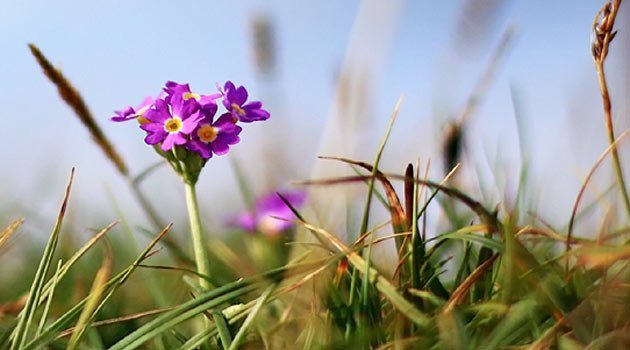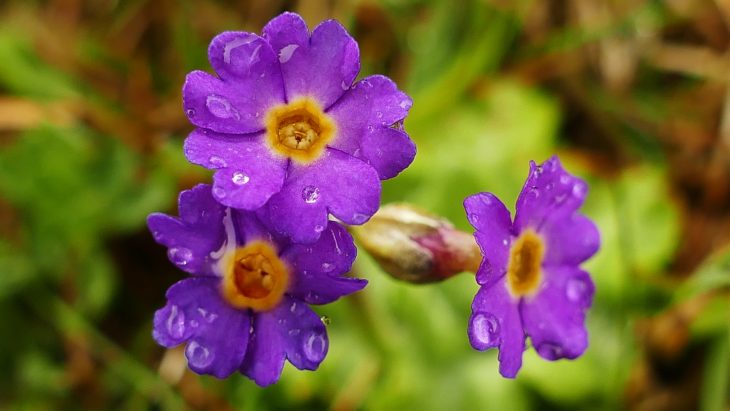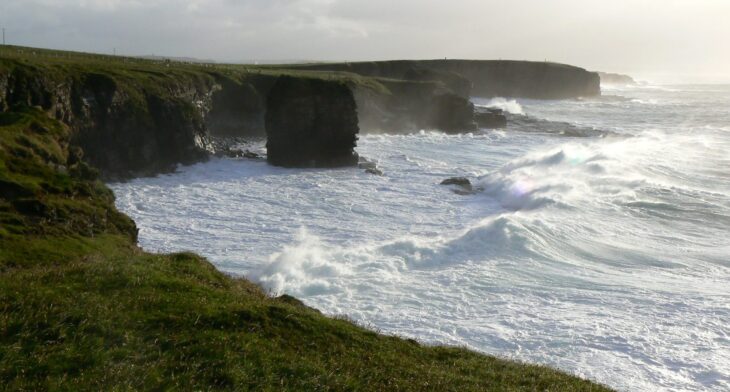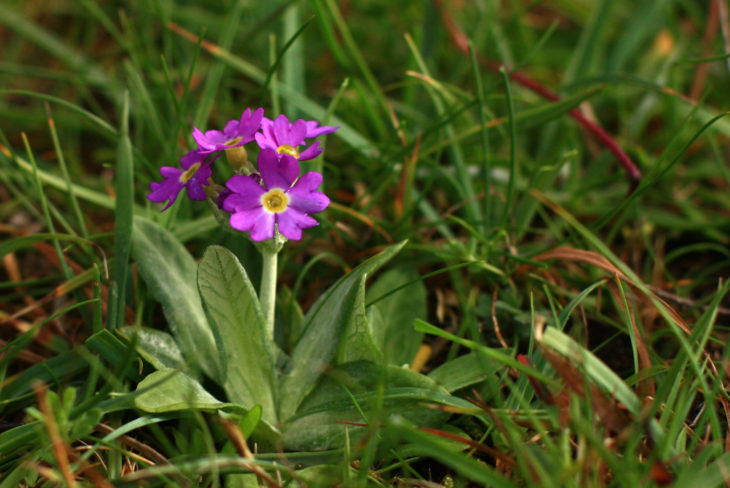Small, pink and perfectly Scottish
Iain MacDonald is a plant advisor at Scottish Natural Heritage. In this guest blog he explains the importance of Scottish primrose, one of the Trust’s priority species and one of only a few plants found solely in Scotland.

I’d read about it, but not seen it. I tried to turn small purple flowers into it, but it was only when I was shown it that I knew what it was about. It was the Scottish primrose, small, pink and much like the drawings of flowers which I drew in school aged five. I first saw it on a botanical field trip to Bettyhill and I was enchanted. More than thirty years later I can hear the words about the mealy underside of the leaves.
This floury texture lends its name to the farinose primroses, of which it is one. It is small, really small, even I was slightly surprised by just how small and I wonder what some visitors might think when they first find it. However I have introduced quite a few people to its glories and hand on heart I can’t recall anyone being derogatory.
On the contrary there have been strange noises of excitement. Literally the plant has brought many people to their knees. And that is the best way to appreciate it, up close and personal. It is the Scottish primrose.It is well known that the Scottish primrose grows on the coast of Orkney, Sutherland and Caithness. Not so well known is that it also grows in the wild at a tiny number of inland sites in Caithness.
‘Inland’ is of course a relative term. We are talking about two or three kilometres, although in the past it used to grow as far inland as Watten – some eight kilometres from the coast. I searched for it there, but couldn’t find it. Perhaps it still clings on in a slightly flushed area where sheep or cattle keep the vegetation short? It would be nice if it did.Slightly inland to the west of Thurso it grows near the top of a hill in a slightly enriched area with short sedges and grasses. At another inland site it grew in short vegetation at the edge of a protected marsh. Perhaps it still does? I looked for it there many years ago, but the habitat just didn’t seem quite right. I searched and searched and in the end had to give up. I climbed over the fence at the edge of the marsh and there it was just outside the protected area – ironically clinging on. I liked its defiance.
It reminded me of another inland population on the east coast of Caithness. The numbers declined over the years, but it still clung on just outside another protected site, no respecter of the conservation plans designed to for it. That is the curious thing about the Scottish primrose, it is possible to kill it with “kindness”.
Having seen it growing in Caithness and Sutherland I knew I needed to see the Scottish primrose in Orkney. I went to what is possibly the best known site, a headland on the west Mainland, superbly exposed even on a calm day and there it was in abundance. A lot of great work has taken place in Orkney to get the grazing regime just right for Scottish primrose.
If you are lucky enough to have Scottish primrose growing on your land, heavier grazing after the plant has set seed in late summer, followed by winter grazing and then a low grazing period before and during flowering is ideal. Work at South Walls found that moving stock about in response to vegetation height worked, but that can of course be labour intensive. Sometimes, though, the best things require a little bit of effort!
The Scottish primrose appears to like short vegetation and although sometimes found close to or on bare areas within quarry floors or wind-blasted heathland, it can grow very well in a close grassland turf. Sometimes it struggles to produce many flowers when grazing is high, but the leaves can endure periods of heavy grazing as they tend to hug the ground.
In areas where there is no grazing during the summer and where surrounded by tall grass, the flowering scape can seem relatively huge, reaching a dizzy 25cm in height! Five cm is morecommon and in a close cropped sward flowers can be only 1cm above the ground.

I read that the Scottish primrose has two flowering periods, but in truth it is possible to find it in flower from late April (rarely) through the summer months. June and July though are the ideal times to find it. I think it is at its best when surrounded by other flowers, thyme, self-heal, purging flax and northern marsh orchids. Species rich-grassland is for me a magical place to be just as the sun is lowering on a mid-summer’s day.
Historically the Scottish primrose used to have a wider range and there have been a few anomalous sites. I recall reading about it from a site in Moray from where it has long since disappeared. Similarly it grew at both Tarbet Ness in Ross-shire and on the links north of Loch Fleet. At these three sites it appears to have been introduced and then died out. The habitat at the three sites looks similar to where it grows naturally, but I guess plants know better than we do about what is right! The most southerly native record that I could find out about was near Helmsdale where the plant is sadly also long gone.

Possibly the most intriguing record was in a book about a travelling naturalist in the 1700’s who noted bird’s-eye primrose from the Western Isles. Bird’s-eye primrose is a closely related species to the Scottish primrose and one of that farinose group. The distribution of bird’s-eye primrose used to extend into the south of Scotland, but populations were lost.
There is an intriguing possibility that the primrose found on the Western Isles was the Scottish primrose as the species was not recognised at that time, the first record being 1819 at Holborn Head west of Thurso. We will probably never know the true identity since neither bird’s-eye primrose nor the Scottish primrose has been confirmed as growing in the Western Isles. It remains intriguing because either species would be a fantastic find at such a location.

It is about twenty years since I last wandered around many of the Scottish primrose sites and I was interested to find out if its fortune had changed, in particular if it still occurred at the few inland sites which I knew about. A report published by SNH and written by Janine Morris titled “Scottish primrose Primula scotica survey in Caithness and Sutherland 2007-2008” contains some interesting, if sad, facts. Janine found that the species had been lost from seven Caithness sites and one site in Sutherland.Just as worrying, there appeared to have been a decline in the number of individuals within populations at many sites.
On a brighter note at some of the sites which I had been worried about the plant is still not only present, but Janine found more than I could recall. Numbers do seem to fluctuate.
The Scottish primrose appears to be a survivor, able to withstand short periods of high or low grazing, but what about global warming? Some plants might respond by moving north, but the Scottish primrose doesn’t have that option. I hope it will be okay.
In the meantime if you happen to be near Watten and find a tiny pink primrose, please let me know…
Help protect Scotland’s wildlife
Our work to save Scotland’s wildlife is made possible thanks to the generosity of our members and supporters.
Join today from just £3 a month to help protect the species you love.
Preface
Iain MacDonald is a plant advisor at Scottish Natural Heritage. In this guest blog he explains the importance of Scottish primrose, one of the Trust’s priority species and one of …
